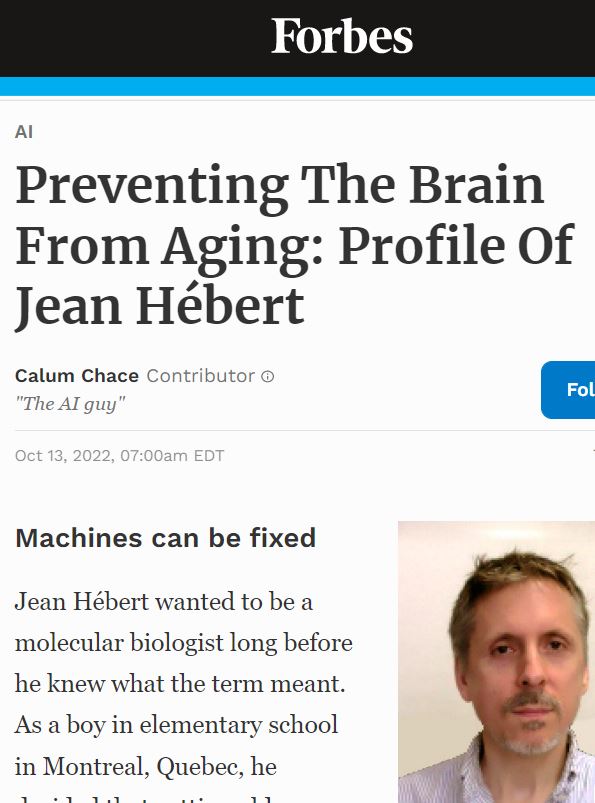Machines can be fixed
Jean Hébert wanted to be a molecular biologist long before he knew what the term meant. As a boy in elementary school in Montreal, Quebec, he decided that getting old was a bad idea. He reasoned that we are essentially machines, so it must be possible to fix our bodies when they suffer damage, and begin to malfunction.
This line of thinking led him all the way to a PhD in genetics, but while doing that he realised that re-engineering the genome to stop aging would be very hard indeed. He decided to change direction, and see if the problem of aging could be better tackled at the cellular level rather than at the genetic level. Cells are the basic units of life, so maybe it would be possible to carry out repairs, and take preventative measures at that level. He started studying stem cells, which can play many roles within the body.
Not all damage is cellular
After a while he realised this was problematic too. Much of the damage that is associated with aging happens in between our cells rather than inside them. In addition, the damage is ferociously complicated, affecting the body’s numerous component materials – like proteins, carbohydrates, and lipids – in a dizzying whirl of interacting processes.
So he shifted his attention up another level, to the organs. It was becoming apparent that before long, it would be possible to replace every organ in the body – either with organs cultivated inside animal donors, or with organs grown in the lab, using a range of different technologies.
The brain cannot be replaced
Every organ except one. We cannot replace the human brain with a new one grown in a donor animal or in a lab. This is a major problem because the brain is our most important organ, the source of our being. Hébert is a fundamentalist on this point: he believes that if you remove the brain from a human and keep it alive in a vat, you will preserve that person. (You might drive them mad, of course, but that does not disprove the claim.)
After completing his PhD he decided to study the neocortex, the six layers of folded tissue that are wrapped around the evolutionarily older parts of the brain, like a wrinkly napkin. The neocortex is where our most valued cognitive functions take place, including consciousness, perception, memory, language, and reasoning. He decided to investigate the possibility of preventing the brain from aging by progressively replacing neocortical tissue.
The plasticity of the brain
There were two reasons to think this might work. First, it was known that the neocortex is plastic, in the sense that functions can move around within it. If the tissues in an area responsible for a particular brain function are damaged, tissues in another area will take over the function. This is just as well. In young people, the brain is relatively compartmentalised: there is an area largely responsible for speech, another area largely responsible for face recognition, and so on. In older brains, much of the brain’s tissue is degraded, so these functions become distributed more evenly around the neocortex.
The second reason for believing that progressive tissue replacement might preserve brain function in the face of aging is that new tissue had successfully been introduced into brains before. There is competition for space in the neocortex, and if new usable tissue becomes available, it will be used. If the process is successful, the presence of fresh new tissue should make it easier to acquire new skills. Which would be handy if you are a person of mature years trying to learn a new language, for instance.
Two workstreams in mice
Hébert’s lab is experimenting with two approaches to progressive tissue replacement in the brains of mice. The first uses fetal tissue, and the other uses stem cells and scaffolding..
Mice are not the ideal animal model for this work, because of their size, and their lifespan. The distance between a mouse’s cortex and its spinal cord is a centimetre, whereas in a human it is much longer. And it takes months for human tissue to mature, whereas it takes only days or weeks in a mouse. Pigs are also frequently used as animal models, and they would solve these issues, but there is a further complication.
To test the efficacy of the treatment, you need to check that the new tissue is replicating the function of the old tissue that it has replaced. For instance, if you were allowed to do this in a human, you might remove a small piece of the motor cortex which controls a forefinger, and replace it with new tissue. You could then check whether the new tissue is working by asking the subject to move their forefinger. If they can, you would silence the specific brain cells in the new tissue to prove that they are generating the movement. Obviously there is no chance of doing this work in humans for the time being, and it is hard to see how you could something analogous with a pig. You could train a primate to perform a similar function, but this would also raise serious ethical issues.
Funding, as always, is the bottleneck
Given the constraints he is working with, Hébert is encouraged by the progress his lab has made so far. It is a multi-disciplinary environment, involving molecular genetics, human embryonic stem cell biology, transcriptomics, surgery, electrophysiology, live brain imaging, and behavioural tests. He estimates that if adequate funding were available, the work could bear fruit in a couple of decades, with an effective therapy to prevent brain aging. It is a startling claim that the organ which generates our minds could become age-proof by the middle of the century.
The funding is not available today, but Hébert reports that promising conversations are under way with a number of parties. These conversations may be helped by the potential for commercial applications along the way. Traditional medicine is making slow progress against strokes, and other diseases of the brain. Progressive tissue replacement could be an effective therapy for those conditions, which could be more palatable to regulators and others than explicitly targeting aging.



